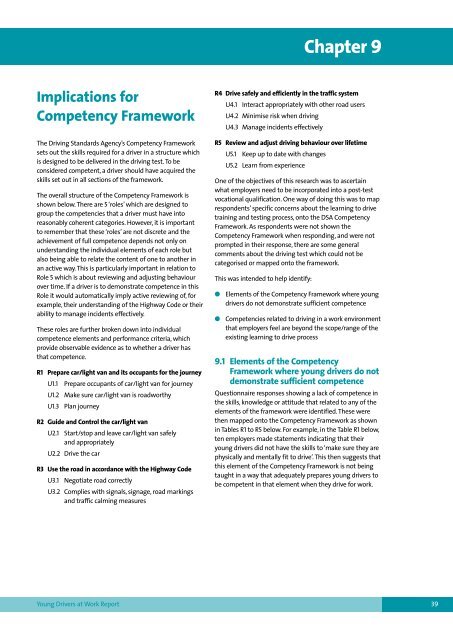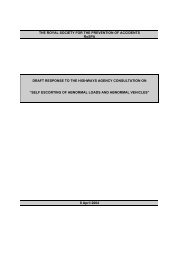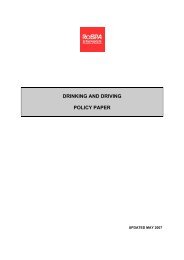RoSPA Young Drivers at Work Report
RoSPA Young Drivers at Work Report
RoSPA Young Drivers at Work Report
Create successful ePaper yourself
Turn your PDF publications into a flip-book with our unique Google optimized e-Paper software.
Chapter 9<br />
Implic<strong>at</strong>ions for<br />
Competency Framework<br />
The Driving Standards Agency’s Competency Framework<br />
sets out the skills required for a driver in a structure which<br />
is designed to be delivered in the driving test. To be<br />
considered competent, a driver should have acquired the<br />
skills set out in all sections of the framework.<br />
The overall structure of the Competency Framework is<br />
shown below. There are 5 ‘roles’ which are designed to<br />
group the competencies th<strong>at</strong> a driver must have into<br />
reasonably coherent c<strong>at</strong>egories. However, it is important<br />
to remember th<strong>at</strong> these ‘roles’ are not discrete and the<br />
achievement of full competence depends not only on<br />
understanding the individual elements of each role but<br />
also being able to rel<strong>at</strong>e the content of one to another in<br />
an active way. This is particularly important in rel<strong>at</strong>ion to<br />
Role 5 which is about reviewing and adjusting behaviour<br />
over time. If a driver is to demonstr<strong>at</strong>e competence in this<br />
Role it would autom<strong>at</strong>ically imply active reviewing of, for<br />
example, their understanding of the Highway Code or their<br />
ability to manage incidents effectively.<br />
These roles are further broken down into individual<br />
competence elements and performance criteria, which<br />
provide observable evidence as to whether a driver has<br />
th<strong>at</strong> competence.<br />
R1<br />
Prepare car/light van and its occupants for the journey<br />
U1.1 Prepare occupants of car/light van for journey<br />
U1.2 Make sure car/light van is roadworthy<br />
U1.3 Plan journey<br />
R2 Guide and Control the car/light van<br />
U2.1 Start/stop and leave car/light van safely<br />
and appropri<strong>at</strong>ely<br />
U2.2 Drive the car<br />
R3 Use the road in accordance with the Highway Code<br />
U3.1 Negoti<strong>at</strong>e road correctly<br />
U3.2 Complies with signals, signage, road markings<br />
and traffic calming measures<br />
R4 Drive safely and efficiently in the traffic system<br />
U4.1 Interact appropri<strong>at</strong>ely with other road users<br />
U4.2 Minimise risk when driving<br />
U4.3 Manage incidents effectively<br />
R5 Review and adjust driving behaviour over lifetime<br />
U5.1 Keep up to d<strong>at</strong>e with changes<br />
U5.2 Learn from experience<br />
One of the objectives of this research was to ascertain<br />
wh<strong>at</strong> employers need to be incorpor<strong>at</strong>ed into a post-test<br />
voc<strong>at</strong>ional qualific<strong>at</strong>ion. One way of doing this was to map<br />
respondents’ specific concerns about the learning to drive<br />
training and testing process, onto the DSA Competency<br />
Framework. As respondents were not shown the<br />
Competency Framework when responding, and were not<br />
prompted in their response, there are some general<br />
comments about the driving test which could not be<br />
c<strong>at</strong>egorised or mapped onto the framework.<br />
This was intended to help identify:<br />
●<br />
●<br />
Elements of the Competency Framework where young<br />
drivers do not demonstr<strong>at</strong>e sufficient competence<br />
Competencies rel<strong>at</strong>ed to driving in a work environment<br />
th<strong>at</strong> employers feel are beyond the scope/range of the<br />
existing learning to drive process<br />
9.1 Elements of the Competency<br />
Framework where young drivers do not<br />
demonstr<strong>at</strong>e sufficient competence<br />
Questionnaire responses showing a lack of competence in<br />
the skills, knowledge or <strong>at</strong>titude th<strong>at</strong> rel<strong>at</strong>ed to any of the<br />
elements of the framework were identified. These were<br />
then mapped onto the Competency Framework as shown<br />
in Tables R1 to R5 below. For example, in the Table R1 below,<br />
ten employers made st<strong>at</strong>ements indic<strong>at</strong>ing th<strong>at</strong> their<br />
young drivers did not have the skills to ‘make sure they are<br />
physically and mentally fit to drive’. This then suggests th<strong>at</strong><br />
this element of the Competency Framework is not being<br />
taught in a way th<strong>at</strong> adequ<strong>at</strong>ely prepares young drivers to<br />
be competent in th<strong>at</strong> element when they drive for work.<br />
<strong>Young</strong> <strong>Drivers</strong> <strong>at</strong> <strong>Work</strong> <strong>Report</strong><br />
39
















